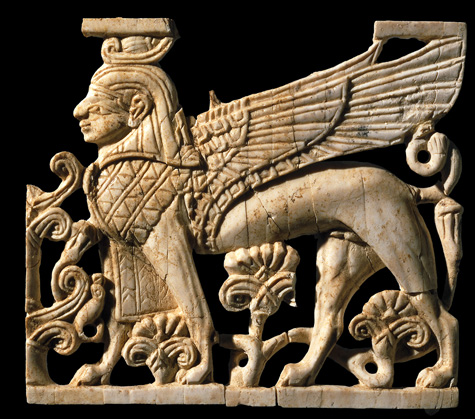
STRIDING SPHINX Stone reliefs that proclaimed Assyrian royal power to visitors and gods and spirits
now do so to us. |
In 1841, Austen Henry Layard was traveling to India, by way of Baghdad, to find work practicing law. But the Brit craved adventure, and he seized every excuse to wander off track. So in what is now northern Iraq, he rode his horse into mounds near Mosul. He spotted pottery shards and fragments of mud bricks that got his mind working over the old tales that this had been the site of the ancient Assyrian capital of Nineveh.“Desolation meets desolation,” Layard wrote, “a feeling of awe succeeds to wonder; for there is nothing to relieve the mind, to lead to hope, or to tell of what has gone by. These huge mounds of Assyria made a deeper impression upon me, gave rise to more serious thoughts and more earnest reflection, than the temples of Balbec and the theatres of Ionia.”
He continued on to what is now Iran but soon abandoned his journey to India, and in 1845 he secured funding (first from a British ambassador, then from the British Museum) to return to Mosul for an archæological dig. The marvels he unearthed are the core of “Art and Empire: Treasures from Assyria in the British Museum,” an exhibit of some 250 objects that will open at the Museum of Fine Arts this Sunday.
The works range from the ninth to the seventh century BC, when Assyria dominated the Near East, ruling lands from present-day Iran to Israel to Egypt. Around 610 BC, its major cities, centered in what is now northern Iraq, were sacked; the empire crumbled, its great mud-brick palaces reverted to mud, and it disappeared into legend. Layard knew it from glancing references by the Greek historian Herodotus, and in the Bible. Genesis says Noah’s grandson Nimrod founded Ninevah. The Book of Kings and the Book of Isaiah tell how the Assyrian king Sennacherib menaced Jerusalem and how the Jewish God struck down 185,000 men in the Assyrian camp and forced the survivors to run home.
Layard was at the vanguard of Westerners exploring the Middle East as the Ottoman Empire’s power waned in the 19th century and European empires expanded their reach. The French vice-council Émile Paul Botta had already uncovered ruins of an Assyrian palace at Khorsabad, north of Mosul. Layard’s excavations quickly turned up palaces at Nimrud (Biblical Calah) to the south and Kuyunjik (Ninevah) just across the Tigris River from Mosul. He found the remains of painted mud-brick buildings, their long, narrow halls lined with gray gypsum (sometimes called alabaster) panels chiseled with scenes of war, subjects bringing tribute to kings, royal life, and guardian figures.

ESCAPE ACROSS A RIVER The highlights of “Art and Empire” are its heart-pounding, sometimes
gory battle scenes. |
There were ubiquitous mud bricks with cuneiform inscriptions (which Europeans had just begun to decipher) proclaiming the glories of the kings: “Shalmaneser, the great king, strong king, king of the world, king of Assyria, son of Ashurnasirpal, the great king, strong king, king of the world, king of Assyria, son of Tikulti-Ninurta, king of the world, king of Assyria.” In the foundations, kings buried stone slabs trumpeting their achievements, promising prosperity and victory to future rulers who restored their buildings and cursing anyone who might erase their names. Layard dug up colossal stone gateway sentinels — often winged bulls or lions with the heads of men. And he found signs that the buildings had been torched.Here at the MFA are decorated bronze door straps, ceramic jars and bottles, bits of furniture, carved ivory sculptures, and decorations for horses. Keep an eye out for five tiny clay dogs — of a sort buried for protection beneath homes — inscribed: “Expeller of evil,” “Catcher of the enemy,” “Don’t think, bite,” “Biter of his foe,” and “Loud is his bark.”
Most impressive are the stone reliefs that lined palace and temple halls proclaiming Assyrian royal power to visitors and gods and spirits — and now to us. Hunting scenes show kings killing lions and bulls. The highlights of the exhibit come about halfway through in a series of gory, heart-pounding battle scenes.
These carvings show Assyrians archers, behind tall shields, assaulting a citadel and scaling the walls on ladders. A wheeled siege engine with giant spears or battering rams climbs a hill to smash the fortress. In another relief, Assyrian archers chase three men into a tree-lined river. One man has been shot in the back. The other two cling to animal skins that they have inflated so they might float down the river toward the shelter of a castle.